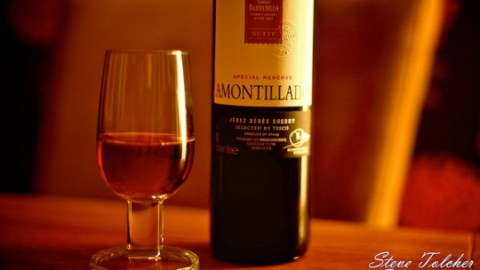Shakespeare: The Original Mad Man

We’ve all seen it – you’re watching a movie and then, suddenly, you realize the camera isn’t focused on the latest star, the tense drama, the exciting action.
Cute-as-a-damn-button Drew Barrymore lures the ugly alien to the house with Reese’s Pieces in ET.
Milton, the office outcast, badgers his colleagues about his red Swingline stapler in Office Space.
Zoe Bell writhes on the hood of the Arctic White 1970 Dodge Challenger as she and her stuntwoman buddies play “ship’s mast’ in Death Proof.
Product placement. It’s clever, it’s annoying, it’s both and most folks believe it’s a 20-21st century phenomenon, with the first one occurring in Howard Hughes’ 1927 movie, Wings.
I thought that, too. But, In preparation to weasel myself, lowly wine columnist, into the ever-so-literary Bigthink.com’s celebration of William Shakespeare’s 448th birthday, I found something else.
I began to think the Bard may just have been the Original Mad Man.
You heard me – I believe William Shakespeare may be the first product placer…and he did it with wine.
A Funny thing Happened on the Way to the Globe Theater
I originally intended to write a piece about how Shakespeare used wine in all his works – as metaphor, as social commentary, as literary device. The more I gathered references to wine, the more it occurred to me he might have had an ulterior motive.
Let’s discuss the kinds of wine found in the plays before we outfit Shakespeare in a sharkskin suit with a narrow tie and a fedora and give him three fingers of Scotch. There are three: Canary, Malmsey and Sack.
Canary
Shakespeare mentions Canary in two plays – The Merry Wives of Windsor and Twelfth Night. In the first play, the Host character retires from act III, scene 2, to go and have a cup of Canary with Shakespeare’s fat, drunken, bon vivant knight, Falstaff. Here’s the line:
Falstaff, and drink canary with him.
In Twelfth Night, Canary is mentioned by Sir Toby Belch, Olivia’s carousing uncle as he talks to a guest.
see thee so put down?
put me down. Methinks sometimes I have no more wit
than a Christian or an ordinary man has: but I am a
great eater of beef and I believe that does harm to my wit.
Now these scenes are unremarkable except that they mention a specific wine. Opensourceshakespeare.org notes that the Bard used the word “wine” 86 times in all his works, but “canary” as a kind of wine only twice. In these two plays, if wine serves as neither a metaphor or plot point, so why mention a specific type of wine? Why not just write the line with the word “wine” instead of “canary”?
Malmsey
I’ll answer that later. Let’s look at the next wine Shakespeare mentions – Malmsey.
Malmsey is mentioned most specifically in three plays: Henry IV, part II, Loves Labour ‘s Lost and Richard III.
In Henry IV, part II, Falstaff is about to enter the scene and he’s described by Hostess Quickly as “malmsey-nosed.” This is no doubt a reference to Falstaff’s fondness for all drink and how it shows on his face. Think WC Fields and his red nose. Here, the wine serves a purpose, but just to illustrate his predilection for alcohol. That could have been achieved with any wine, right?
In Love’s Labour’s Lost, Malmsey is mentioned in a bit of banter between Biron and the Princess of France that reminds me of dialogue from Screwball comedy films of the 1940’s. Here’s a piece of the scene:
Metheglin, wort, and malmsey: well run, dice!
There’s half-a-dozen sweets.
Since you can cog, I’ll play no more with you.
Again, clever dialogue but, no signficance. Why mention Malmsey by name? Why not just say “sweet wine”?
In Richard III, when Richard’s men murder the Duke of Clarence, they plan to murder him and conceal the body in a barrel of Malmsey. This could have been any wine. Why choose Malmsey to pickle the corpse?
Shock value is a factor here, to be sure – people bought wines directly from the barrel and Shakespeare knew this – but why allude to a specific wine barrel for the Duke’s coffin?
Sack
Finally, let’s look at Sack. Sack was the Elizabethan term for Sherry. Introduced to the English people by way of treasure looted from Sir Francis Drake’s attack on the Spanish city Cadiz in 1587, Sack was by far the most popular wine in England during Shakespeare’s lifetime.
This popularity is reflected in Shakespeare’s works. A search for “Sack” yields 56 mentions of the word and I was able to find 34 of them referring to the wine itself. In short, it’s everywhere.
Twenty-nine uses of the word “Sack” as wine arise in Henry IV, V and VI, with 24 mentions in both parts of Henry IV. Of those 24 uses, 17 of them come from, or in reference to, Sir John Falstaff.
The word occurs too many times to review each, but one passage merits inclusion. Falstaff extols the virtues of Sack, explaining how drinking it might better prepare young men like Prince Harry, soon to ascend to the sable mantle of royalty, to the capriciousness of life ahead. You can find the entire soliloquoy here:
Shakespeare as 16th century Mad Man? Really?
Now to the unanswered questions above. Why Canary? Why Malmsey? Why Sack? The answer’s simple: Shakespeare wanted his audience to buy the wines. He follows three basic commandments of product placement to convince them.
One – Advertise specific brands. I’ll admit it – at first blush, this doesn’t resemble modern placement – no brands, no labels, no specific winemaker. Shakespeare only mentions the grapes or the locations where the wines were made.
Here’s the answer to that question: calling a wine by its specific grape or its region was the genesis of modern branding. People knew Sack or Burgundy or Mosel wines exactly, precisely, solely because those were the only places you could find wine that tasted that way.
That remains, to this day, the definition of branding – you must buy this thing from us. It cannot be found any other place.
Two – To make a product more attractive, have the most appealing character use it. If Falstaff – jolly, warm and larger than life despite his faults – drinks Sack, so should you! See? I’m as boisterous, sweet and charismatic as Falstaff! How could I not be with a glass of Sack in my hand!?
Three – Play to the demographic most likely to buy your product. In this case it was the wealthy, as ale was the libation of choice for the groundlings. Only the wealthy could afford wines like Canary, Malmsey and Sack.
I think I’ve made a pretty good argument that Shakespeare not only was the first product placer, he did it with wine. I have no direct, historical evidence he paid to use these brands, but that I leave to further research. Just because no one’s found any evidence to support the idea, doesn’t mean he didn’t do it. Sounds like a good dissertation topic.
I prefer to assess the affair this way: In a time where some scholars posit that Shakespeare was an apocryphal character, who didn’t write all his plays and couldn’t have achieved all that was ascribed to him, I prefer to think of Bill as not only a genius in drama, language and showmanship, but as a marketing genius, too. how’s that for academic contrarianism?
Hmmm, a glass of Oloroso Sherry sounds tasty, anon.




